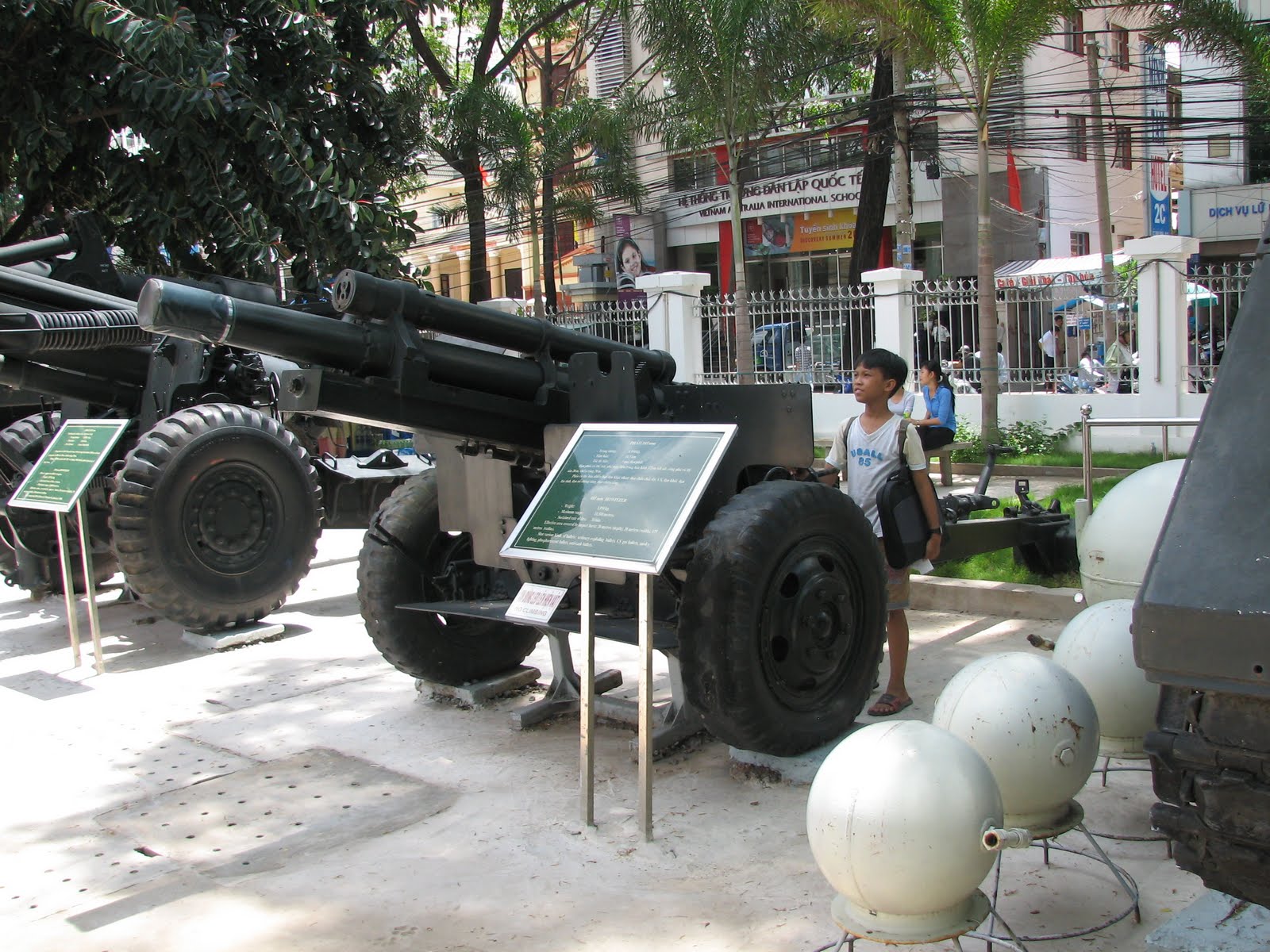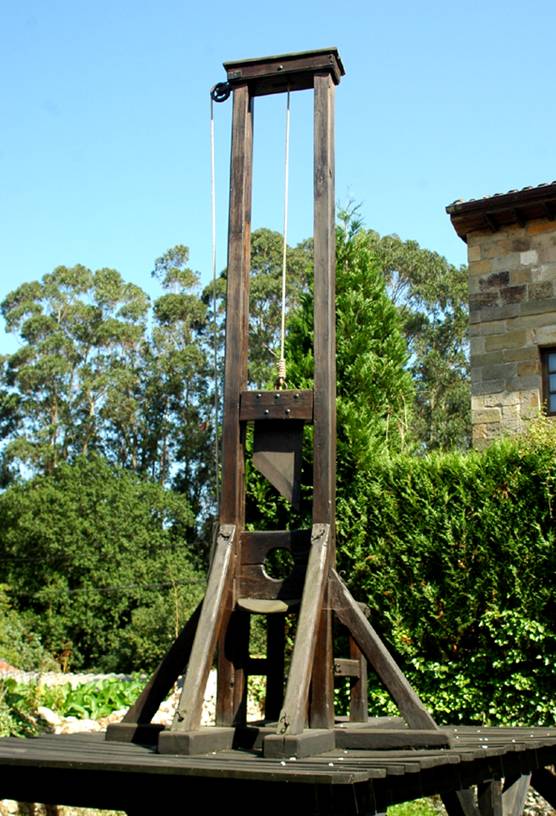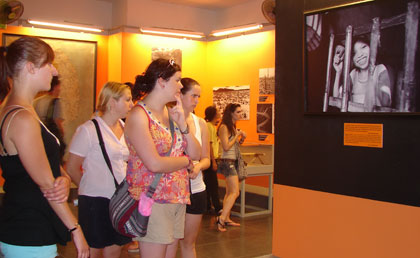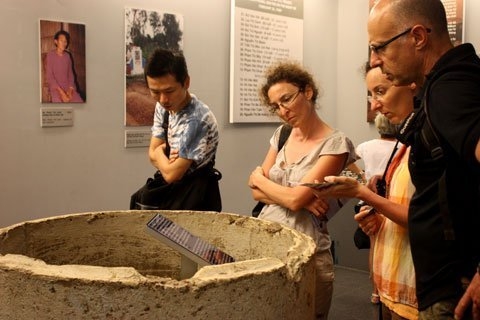Through this article I think you may know more About Vietnam. So are you ready to discover more interesting things in my country? Operated by the Vietnamese government, the War Remnants Museum (Bảo Tàng Tội Ác Chiến Tranh) was opened in September 1975 as the “The House for Displaying War Crimes of American Imperialism and the Puppet Government [of South Vietnam].”
 Later it was known as the Museum of American War Crimes, then as the War Crimes Museum until as recently as 1993. Its current name follows liberalization in Vietnam and the normalization of relations with the United States, but the museum does not attempt to be politically balanced.
Later it was known as the Museum of American War Crimes, then as the War Crimes Museum until as recently as 1993. Its current name follows liberalization in Vietnam and the normalization of relations with the United States, but the museum does not attempt to be politically balanced.
Its exhibits speak for themselves, a distressing compendium of the horrors of modern warfare. Some of the perpetrators of these horrors are on display in the courtyard outside, including a 28-tonne howitzer, a ghoulish collection of bomb parts, and a renovated Douglas Skyraider plane. When mention About Vietnam, especially in Ho Chi Minh City, there still have many information you should know.
 A series of halls present a grisly portfolio of photographs of mutilation, napalm burns and torture. One gallery details the effects of the 75 million liters of defoliant sprays dumped across the country, including hideously malformed fetuses preserved in pickling jars; another looks at international opposition to the war as well as the American peace movement.
A series of halls present a grisly portfolio of photographs of mutilation, napalm burns and torture. One gallery details the effects of the 75 million liters of defoliant sprays dumped across the country, including hideously malformed fetuses preserved in pickling jars; another looks at international opposition to the war as well as the American peace movement.
 Tiger Cages
Tiger Cages
The museum rounds off with a grisly mock-up of the tiger cages, the prison cells of Con Son Island. There’s a water puppetry theatre (daily 9-11am & 2-4pm; $2) opposite the souvenir shop. A minimum of five people are required for a performance.
 The museum is effectively a propaganda museum for the Vietnamese Communist regime, as it almost exclusively displays exhibits that are highly critical of the South Vietnamese and American war efforts during the Vietnam War, while neglecting to exhibit anything critical of the North Vietnamese or Viet Cong’s war effort or atrocities, for example of the Hue Massacre, the Dak Son Massacre and the Chau Doc massacre, the many land mines scattered across rural southern Vietnam that still lay undetonated often injuring rural villagers (particularly children) today, the brutal treatment of American Prisoners of War (POWs) between 1964 and 1973, and the brutal treatment of political prisoners in labor camps (reeducation camps) run by the North Vietnamese and the Viet Cong during and after the war. This place shows really clearly the truth about the pain of people About Vietnam that time.
The museum is effectively a propaganda museum for the Vietnamese Communist regime, as it almost exclusively displays exhibits that are highly critical of the South Vietnamese and American war efforts during the Vietnam War, while neglecting to exhibit anything critical of the North Vietnamese or Viet Cong’s war effort or atrocities, for example of the Hue Massacre, the Dak Son Massacre and the Chau Doc massacre, the many land mines scattered across rural southern Vietnam that still lay undetonated often injuring rural villagers (particularly children) today, the brutal treatment of American Prisoners of War (POWs) between 1964 and 1973, and the brutal treatment of political prisoners in labor camps (reeducation camps) run by the North Vietnamese and the Viet Cong during and after the war. This place shows really clearly the truth about the pain of people About Vietnam that time.

 The fact that the War Remnants Museum used to be known as the Museum of Chinese and American War Crimes is a good indication as to who the Vietnamese have chosen to portray as the bad guys in this exhibit.
The fact that the War Remnants Museum used to be known as the Museum of Chinese and American War Crimes is a good indication as to who the Vietnamese have chosen to portray as the bad guys in this exhibit.

This is the second part of my multi tips around the War Remnants Museum (Bảo Tàng Tội Ác Chiến Tranh), with the assorted captured military equipment from the US Army and the ARVN (Army of the Republic of Vietnam). Let continue to my trip to discover more this museum to let you know more About Vietnam.
 The now enlarged yard outside the main building houses assorted military equipment, which include a UH-1 “Huey” helicopter, an F-5A fighter, a BLU-82 “Daisy Cutter” bomb, M48 Patton tank, an A-1 Sky raider attack bomber, and an A-37 Dragonfly attack bomber.
The now enlarged yard outside the main building houses assorted military equipment, which include a UH-1 “Huey” helicopter, an F-5A fighter, a BLU-82 “Daisy Cutter” bomb, M48 Patton tank, an A-1 Sky raider attack bomber, and an A-37 Dragonfly attack bomber.
 Several display aircraft (F-5, A-37) have non-standard markings indicating “U.S. Air Force,” but are in fact former South Vietnamese Air Force (VNAF) aircraft. You can take pictures and videos of the equipment on display. There are many things for you to discover About Vietnam through this war museum.
Several display aircraft (F-5, A-37) have non-standard markings indicating “U.S. Air Force,” but are in fact former South Vietnamese Air Force (VNAF) aircraft. You can take pictures and videos of the equipment on display. There are many things for you to discover About Vietnam through this war museum.
 The museum contains exhibitions related to the American phase of the Vietnam War. The exhibitions are housed in several buildings and the themes are: “Historical Truths”, “Requiem” – (a photo collection taken by war reporters killed during the Vietnam War), “Vestiges of War Crimes”, “Imprisonment System” – (including a model of the Tiger Cages), “Vietnam – War and Peace” – ( a photo collection), “International Support”, “War and Peace” – (a collection of children’s paintings), and in the museum yard you will find an exhibition of weapon used in the Vietnam War (tanks, planes, missiles, helicopters and more).
The museum contains exhibitions related to the American phase of the Vietnam War. The exhibitions are housed in several buildings and the themes are: “Historical Truths”, “Requiem” – (a photo collection taken by war reporters killed during the Vietnam War), “Vestiges of War Crimes”, “Imprisonment System” – (including a model of the Tiger Cages), “Vietnam – War and Peace” – ( a photo collection), “International Support”, “War and Peace” – (a collection of children’s paintings), and in the museum yard you will find an exhibition of weapon used in the Vietnam War (tanks, planes, missiles, helicopters and more).
The First Level of the Building Houses the Children’s Painting Collection, the International Support for the Vietnamese People Pavilion (mostly communist countries like Cuba, China, then Soviet Union, North Korea and prominent western communist leaders), and assorted hand-held weapons used in the war enclosed in glass panels.
The SECOND Level of the Building Houses the Aggression War Crimes Pavilion and the Agent Orange Aftermath Pavilion, where photos and documentaries of the victims of Agent Orange and other assorted “horrors” of the war is featured plus several unborn fetuses with deformities due to Agent Orange.
 The Third Level of the Building Houses Historical Truths Pavilion (A room containing photographs, propaganda, news clippings, and signboards geared toward showing the wrongdoings of the U.S. government in the 1960s and 1970s.). Requiem Pavilion (A powerful collection of photographs taken by 134 international journalists who were killed during the Vietnam War), Vestiges of War Crimes Pavilion (Another room heavily dosed with propaganda showing the mistreatment of civilians during the war) and the Vietnam Post War Recovery Pavilion.
The Third Level of the Building Houses Historical Truths Pavilion (A room containing photographs, propaganda, news clippings, and signboards geared toward showing the wrongdoings of the U.S. government in the 1960s and 1970s.). Requiem Pavilion (A powerful collection of photographs taken by 134 international journalists who were killed during the Vietnam War), Vestiges of War Crimes Pavilion (Another room heavily dosed with propaganda showing the mistreatment of civilians during the war) and the Vietnam Post War Recovery Pavilion.

It is not a museum for everyone – gruesome photos of the My Lai massacre and of victims of napalm bombs and Agent Orange. This is the end of my trip, this museum made me a high impressive as well as sympathy to the people in the past. How do you think? You know more About Vietnam now?
 From the exhibited remnants I saw, I believe that what happened during those times are lessons in order to be learned. It’s not easy to look back on the very bad situations that took place but when you see the purpose of it, it means that we have to move on and help each other; after all it’s the reason why we are here on earth.
From the exhibited remnants I saw, I believe that what happened during those times are lessons in order to be learned. It’s not easy to look back on the very bad situations that took place but when you see the purpose of it, it means that we have to move on and help each other; after all it’s the reason why we are here on earth.
The relationship between Vietnam, France and USA now is getting better. They are doing business and trading as well as working for peace purpose together. The purpose of this article is reflect the cruel of war in the past and the long its effect to many victims, not criticize or blame any words on France and USA. I think after reading this article and visiting the museum, you might know more About Vietnam and stand for peace for next generation.

Although the recent name change will avoid offending Chinese and American tourists, the pamphlets passed out at the entrance pull no punches, warning stoically, “Some pictures of U.S. imperialists’ aggressive war crimes in Vietnam.” This is the first part of War Remnants Museum, the following parts will let you know more About Vietnam, especially this place.
From EZ Vietnamese Cuisine Team.



